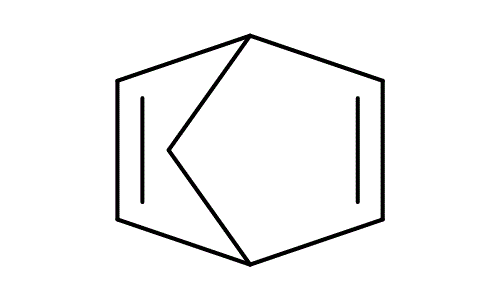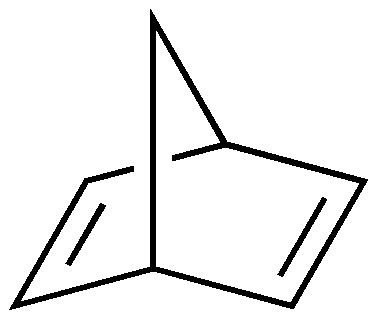Molar mass 92.14 g/mol Density 906 kg/m³ Pubchem 8473 | Formula C7H8 Boiling point 89.5 °C | |
 | ||
Norbornadiene is a bicyclic, hydrocarbon and an organic compound. Norbornadiene is of interest as a metal-binding ligand, whose complexes are useful for homogeneous catalysis. It has been intensively studied owing to its high reactivity and distinctive structural property of being a diene that cannot isomerize (isomers would be anti-Bredt olefins). Norbornadiene is also a useful dienophile in Diels-Alder reactions.
Contents

Synthesis
Norbornadiene can be formed by a Diels-Alder reaction between cyclopentadiene and acetylene.
Reactions

Quadricyclane, a valence isomer, can be obtained from norbornadiene by a photochemical reaction when assisted by a sensitizer such as acetophenone:

The norbornadiene-quadricyclane couple is of potential interest for solar energy storage when controlled release of the strain energy stored in quadricyclane back to norbornadiene is made possible.
Norbornadiene is reactive in cycloaddition reactions. Norbornadiene is also the starting material for the synthesis of diamantane and sumanene and it is used as an acetylene transfer agent for instance in reaction with 3,6-di-2-pyridyl-1,2,4,5-tetrazine.
As a ligand
Norbornadiene is a versatile ligand in organometallic chemistry, where it serves as a two-electron or four-electron donor. The norbornadiene analogue of cyclooctadiene rhodium chloride dimer is widely used in homogeneous catalysis. Chiral, C2-symmetric dienes derived from norbornadiene have also been described.
One example is tetracarbonyl(norbornadiene)chromium(0), which is a useful source of "chromium tetracarbonyl," e.g. in reactions with phosphine ligands.
